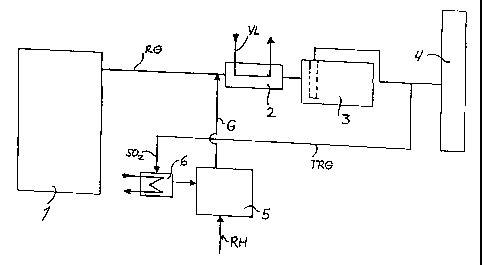Some of the information on this Web page has been provided by external sources. The Government of Canada is not responsible for the accuracy, reliability or currency of the information supplied by external sources. Users wishing to rely upon this information should consult directly with the source of the information. Content provided by external sources is not subject to official languages, privacy and accessibility requirements.
Any discrepancies in the text and image of the Claims and Abstract are due to differing posting times. Text of the Claims and Abstract are posted:
| (12) Patent: | (11) CA 2372474 |
|---|---|
| (54) English Title: | METHOD OF REMOVING MERCURY FROM FLUE GASES |
| (54) French Title: | METHODE D'EXTRACTION DE MERCURE DES GAZ DE COMBUSTION |
| Status: | Expired and beyond the Period of Reversal |
| (51) International Patent Classification (IPC): |
|
|---|---|
| (72) Inventors : |
|
| (73) Owners : |
|
| (71) Applicants : |
|
| (74) Agent: | BORDEN LADNER GERVAIS LLP |
| (74) Associate agent: | |
| (45) Issued: | 2010-04-20 |
| (22) Filed Date: | 2002-02-15 |
| (41) Open to Public Inspection: | 2002-08-16 |
| Examination requested: | 2007-01-08 |
| Availability of licence: | N/A |
| Dedicated to the Public: | N/A |
| (25) Language of filing: | English |
| Patent Cooperation Treaty (PCT): | No |
|---|
| (30) Application Priority Data: | ||||||
|---|---|---|---|---|---|---|
|
A method of removing metallic mercury and ionic mercury from flue gases, especially of a power plant, is provided. A gas that contains sulfur dioxide, or other adequate amounts of sulfur in the form of H2S or COS and a gas that contains hydrogen, are conveyed to a catalyzer for producing a gas that contains elemental sulfur and hydrogen sulfide. This gas is conveyed to flue gas upstream of a separator, wherein mercury in the flue gas reacts with the sulfur and ionic sulfur in the gas and is separated out in the separator.
Divulgation d'une méthode pour éliminer du mercure métallique et du mercure ionique de gaz de carneau, particulièrement de ceux d'une centrale énergétique. Un gaz contenant du dioxyde de soufre, ou du soufre en quantité suffisante sous forme de H2S ou de COS, et un gaz contenant de l'hydrogène sont acheminés jusqu'à un catalyseur pour produire un gaz contenant du soufre élémentaire et du sulfure d'hydrogène. Ce gaz est acheminé jusqu'au gaz de carneau en amont d'un séparateur, où le mercure contenu dans le gaz de carneau réagit avec le soufre et le soufre ionique dans le gaz et est séparé dans le séparateur.
Note: Claims are shown in the official language in which they were submitted.
Note: Descriptions are shown in the official language in which they were submitted.

2024-08-01:As part of the Next Generation Patents (NGP) transition, the Canadian Patents Database (CPD) now contains a more detailed Event History, which replicates the Event Log of our new back-office solution.
Please note that "Inactive:" events refers to events no longer in use in our new back-office solution.
For a clearer understanding of the status of the application/patent presented on this page, the site Disclaimer , as well as the definitions for Patent , Event History , Maintenance Fee and Payment History should be consulted.
| Description | Date |
|---|---|
| Time Limit for Reversal Expired | 2017-02-15 |
| Letter Sent | 2016-02-15 |
| Letter Sent | 2015-07-07 |
| Inactive: Single transfer | 2015-06-19 |
| Inactive: Cover page published | 2010-04-20 |
| Grant by Issuance | 2010-04-20 |
| Inactive: Final fee received | 2010-02-02 |
| Pre-grant | 2010-02-02 |
| Notice of Allowance is Issued | 2009-08-31 |
| Letter Sent | 2009-08-31 |
| Notice of Allowance is Issued | 2009-08-31 |
| Inactive: Approved for allowance (AFA) | 2009-08-26 |
| Amendment Received - Voluntary Amendment | 2009-06-29 |
| Inactive: S.29 Rules - Examiner requisition | 2009-01-22 |
| Inactive: S.30(2) Rules - Examiner requisition | 2009-01-22 |
| Letter Sent | 2007-01-17 |
| Request for Examination Requirements Determined Compliant | 2007-01-08 |
| Request for Examination Received | 2007-01-08 |
| All Requirements for Examination Determined Compliant | 2007-01-08 |
| Letter Sent | 2005-02-04 |
| Letter Sent | 2005-02-04 |
| Inactive: Correspondence - Transfer | 2004-12-17 |
| Inactive: Office letter | 2004-08-04 |
| Inactive: Single transfer | 2004-06-18 |
| Application Published (Open to Public Inspection) | 2002-08-16 |
| Inactive: Cover page published | 2002-08-15 |
| Inactive: IPC assigned | 2002-04-12 |
| Inactive: IPC assigned | 2002-04-12 |
| Inactive: IPC removed | 2002-04-12 |
| Inactive: First IPC assigned | 2002-04-12 |
| Inactive: Filing certificate - No RFE (English) | 2002-03-19 |
| Filing Requirements Determined Compliant | 2002-03-19 |
| Letter Sent | 2002-03-19 |
| Application Received - Regular National | 2002-03-19 |
There is no abandonment history.
The last payment was received on 2010-01-22
Note : If the full payment has not been received on or before the date indicated, a further fee may be required which may be one of the following
Please refer to the CIPO Patent Fees web page to see all current fee amounts.
Note: Records showing the ownership history in alphabetical order.
| Current Owners on Record |
|---|
| STEINMULLER BABCOCK ENVIRONMENT GMBH |
| Past Owners on Record |
|---|
| REINHARD HOLSTE |
| WOLFGANG FEY |